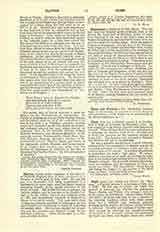

Cleef, JOOST VAN (JOSSE VAN CLEVE), the “Madman”, a Flemish painter, b. in Antwerp c. 1520; died c. 1556. He was one of twenty van Cleefs who painted in Antwerp, but whether the well-known Henry, Martin, and William (the younger) were kin of his cannot be determined. Of his father, William (the elder), we know only that he was a member of the Antwerp Academy, which body Joost joined, Joost was a brilliant and luminous colorist, rivaling, in this respect, the Italians, whose methods he followed. Severity and hardness of outline somewhat marred his otherwise fine draughtsmanship. Portraiture in the sixteenth century was represented by Joost van Cleef; and Kugler places him, artistically, between Holbein and Antonio Moro, his “Portrait of a Man” in Munich (Pinakothek) being long attributed to Holbein. He painted in France, England, and Germany. The celebrated portrait painter of Cologne, Bruyn, was his pupil. Imagining himself unappreciated, he went to Spain and was presented to Philip II by Moro, the court painter.
Because Henry VIII, according to English authorities, chose Titian‘s pictures in preference to his, van Cleef became infuriated, and his frenzy later developed into permanent insanity. The French contend that it was Philip, in Spain, who gave Titian the preference. The most distressing feature of Joost’s insanity was that he retouched and ruined his finished pictures whenever he could gain access to them, and his family finally had to place him under restraint.
Beautiful altar-pieces by van Cleef are found in many Flemish churches, notably “The Last Judgment” (Ghent). Perhaps the most celebrated of his works is the “Bacchus” (Amsterdam), whose young face is crowned with prematurely grey hair. “A Virgin” (Middleburg) is noteworthy as having a charming landscape for the background, a combination rare in those days. Other works are “Portrait of the Painter and his Wife”, at Windsor Castle; “Portrait of a Young Man“, at Berlin; and “Portrait of a Man“, at Munich.
LEIGH HUNT

